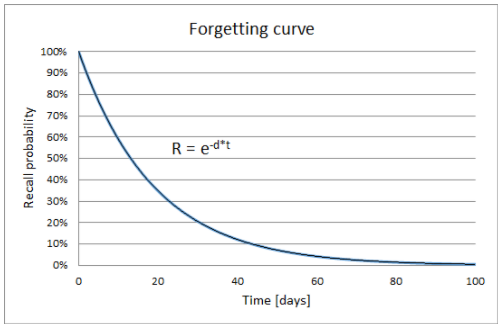Mixed repetitions on SuperMemo.com
Have you ever used mixed repetitions on SuperMemo.com? Check out how they work!

The ability, or likelihood of remembering something is expressed on a scale from 0 to 100%. Typically, immediately after learning something new, we’re able to recall it with nearly 100% effectiveness. With time, though, the ability to recall it falls — even to zero. This takes place until such time as the information is refreshed, for example by naturally being used or through an artificially created repetition. Of course, you can also use the SuperMemo method, based on spaced repetition.
So, what is it? After all, either you remember, or you don’t — how can memory, which is binary, be expressed as a percentage? What might be hard to imagine in relation to a single piece of information can be illustrated with an experiment in memorising a larger amount of similar material (just read about the famous research and the forgetting curve of Ebbinghaus). You can try a simple experiment by trying to memorise 100 totally new words to you in English or any other foreign language. If you test how many of them you can remember 3, 6 or 9 days after first learning them, you’ll see that the longer the time since you first learned them to the time that you test them, the fewer words you’re able to remember. For example, after 3 days you might remember 80 of them, after 6 days 40, and after 9 days you can only recall 20 of the 100 words you learned. If, on the day of the test, you can recall 80 words, that means that the likelihood of remembering any individual word is, on average, 80/100, or 80%.
Of course, the result of such an experiment is going to vary from person to person, or by the amount of material, or even what time of day the test is done. Effective memorisation is heavily dependent on pre-existing associations and connections, and so the information already present in our brains. The more any new information fits into what we already know, the easier it is to acquire. And the reverse is true, too. The more anything which you are trying to learn is at odds with your hitherto image of the world, the more of a struggle it will be to learn. That’s why learning a new language is, to begin with, pretty difficult, but if you get over the barrier of learning the basic structures, it gets more and more pleasurable. The time of day is also important, because of our natural circadian rhythms. Our brains can more effectively acquire and solidify an item of memory when we’re fresh and rested, than when the body is sending us signals that it needs to rest.
Because learning is a highly individual process, there isn’t a single forgetting curve for everyone. However, we can establish its fundamental mathematical form and the rules which govern solidifying information in our memories. On the basis of his own research, experiments and deductions, back in the ‘90s, the creator of the SuperMemo method, Dr Piotr Woźniak, together with other researchers, proved that the process of forgetting follows a curve which can be expressed using a negative exponential function whose Euler number (e=2.71828…) is raised to a negative power. An exponential function is used to describe certain natural phenomena, such as the process of radioactive decay. It’s extraordinary that our memories (memory traces) disappear over time much the same as the spontaneous decay of radioactive particles.

Forgetting curve. Source: SuperMemo research
The curve shown in the graph can take any number of forms, depending on the parameters d, and t, where d is the recall probability and t is the time passed. The specific forgetting curve for a given individual, though, can be estimated if we know the laws which govern long-term memory. These laws were defined by the creators of the SuperMemo method in the two-component model of memory which they created. In 1995, this was published in the academic journal Acta Neurobiologiae Experimentalis. These two components, which describe the condition of any memory trace at a given moment, are retrievability and stability. Retrievability defines the likelihood of being recalled, while stability — how strong the memory is, and so how rapidly its retrievability will fall. Thanks to a familiarity with the properties of memoranda by observing the history of its users, SuperMemo is able to predict how well an individual item can be retrieved and propose the optimal moment to revise it.